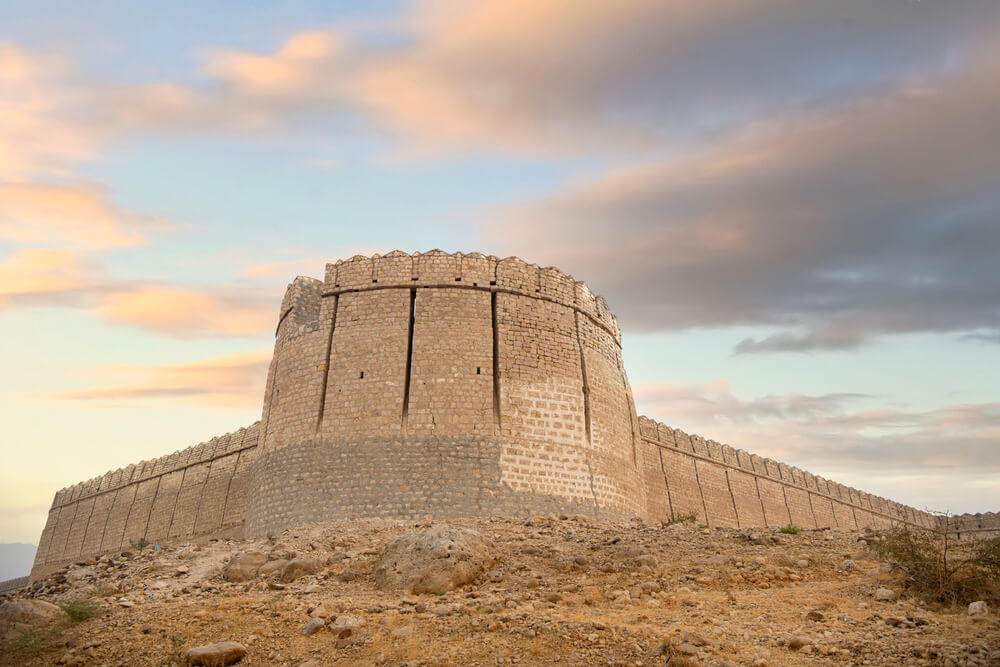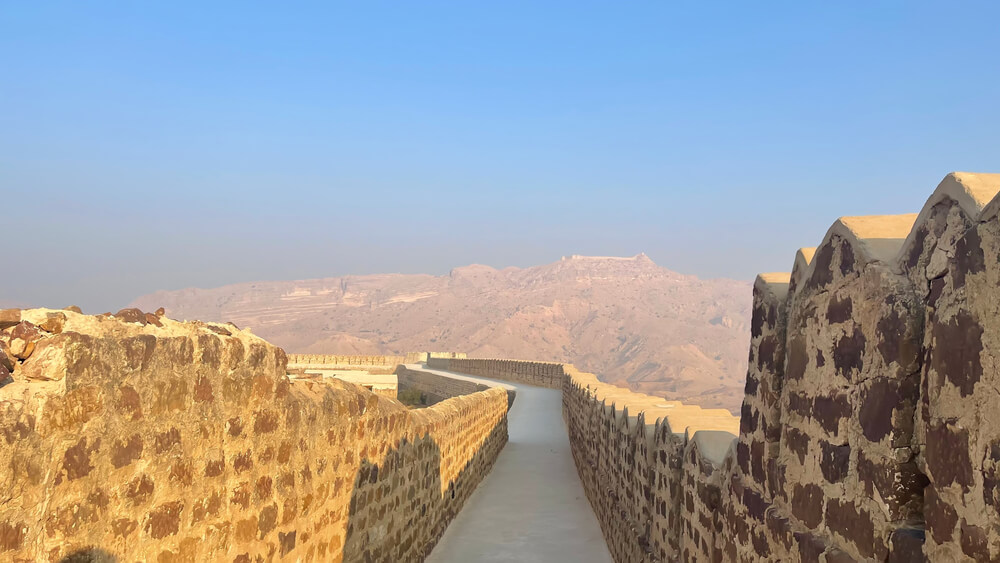Miri Fort – The Quintessential Historical Monument of Quetta
Quetta is the largest and the liveliest city in the Baluchistan province. The city offers numerous sightseeing options, including the famous Hanna Lake and Urak valley. It is an excellent location for shopaholics as you will find almost everything in the Quetta Bazar at very low prices. Quetta has a significant market of Irani handmade carpets with beautiful intricate patterns. The great Miri Forts sits right in the middle of the city, still tall and strong even after centuries. The fort is well preserved and offers a variety of artifacts from the past.
Miri fort is a quintessential historical monument of Quetta that has withstood the test of time. It is one of Quetta’s most important places in terms of historical and archaeological value. The fort was built by the Hindu rulers who once ruled this region, and it served as their stronghold and palace. The structure of the Miri fort is quite imposing, and its walls still bear testimony to the grandeur of those times.
It has great importance for the Hindu community. The fort was initially constructed as a Hindu temple in the 15th century by the local king, but it was later converted into a fort by the Muslim rulers.
Miri Fort Quetta Attractions, Ticket, Timings, and Location
The word Miri originated from the brave language, meaning chief or head of the clan. Miri means the house of chiefs, or it could be named after the local tribe marri. However, people generally agree that it’s Miri and not marri fort. In 1884, it was named to be the crown of Quetta. Some say that the base of the fort is a mud volcano from prehistoric days. However, no one is sure because the fort is very old, and many theories are associated with this stronghold. The fort was assigned as the residence of the governor, who the khan of Kalat appointed. Later, the British used the fort as arsenal storage for the city.
History of Miri Fort Quetta
Miri fort is an elliptical shape with its length reaching up to 600ft. The height of the fort is 60ft, and the breadth is 400ft. In this heap of hard earth, there used to be some houses that might have had the tribal Sardars. While clearing the top of the fort, 15 feet of dirt above the mound was removed, creating an extra 5 feet of depth. The soil excavated was full of charcoal, ashes in layers, demolished pottery, and bones of animals. Some other articles of interest found from the mound were archaic type pottery, jasper corn crusher, ring stone, and bronze vessel that existed in prehistoric times. Miri Fort is one of the most historical Fort in Pakistan.

The fort was altered in all eras to preserve its perfect structure and make it more robust and sturdy.
The Englishmen installed the red railing around the fort in place of the trench. Some people think that the mound is not natural and may have been made by the mud carried here by the army of Ahmad shah Abdali, who traveled to India through the famous Bolan Pass.
Attractions At Miri Fort
Miri fort is a perfect day trip option in Quetta. Even though it may only look like a mound of clay, it had an important strategic position. It was made to guard the entrance of the city from the west. The Miri fort is not just a single stronghold. There are some other must-see things in Miri fort. Apart from its incredible architecture, you will also find a museum and a fully functional temple in the vicinity. It is under the direct control of the Pakistan army, which is also using it for ordnance-related purposes.
The architecture and design of the fort are very thoughtful and create an impact on the onlookers. The fort is enclosed by walls and can be accessed easily. The fort is 20km from the Quetta international airport, and you will find clear directions to your destination.
Here are some of the most exciting things that are worth mentioning.
Wide and Spacious Staircases
Like many other historical buildings, the Miri fort also has wide and spacious stairs, so you will not have to line up to climb them. Each step of the staircase is a sturdy stone offering a proper place to set foot and move to the top.
Airy Lobbies
The lobbies were made very airy to ensure that the inside of the fort would remain comfortable and consistent, especially during the summers. These lobbies were perfect for sunlight during the day, which helped keep the fort dry and clean. As you visit the fort and pass through these lobbies, you will inhale fresh cool air, a characteristic of the atmosphere of Quetta.

Underground Jails
Back in time, it was a tradition to have underground jails to cut off convicts from the rest of the world. It is also a way to ensure they are under strict surveillance and do not get any chance to break away. The underground jail of the fort will give you chills down the spine. It’s hard to think how prisoners were forced to live in such conditions.
Barren Wells
The city of Quetta is a symbol of life in Balochistan. Most of the province is barren, and the area has limited water reservoirs. The existence of these dried-up wells shows that centuries ago, this place was a home for someone and had surplus water that must have attracted many people.
Musketry Position
The fort also houses a massive collection of long musket guns. Soldiers from the 18th century used swords, rifles, and shields. An entire fort wall is in line with these hanging muskets displayed in frames. These guns were also a sign of domination in the region, and when the British came, they had better weapons and ammunition.

Sun Room
Sunrooms are also an integral part of all old constructions. The temperature of the city is shallow during the peak winter months. The brain-freeing wind also blows which did not allow the people of the fort to head out under the sun. in such circumstances, the fort’s sun came in handy. It was also an ideal option for the families and women of the chiefs who didn’t leave the house efficiently.
Museum
The fort now houses a museum that displays a wealth of artifacts from the Hindu period. The most striking feature of the museum is the statue of Lord Vishnu, which is believed to date back to the 12th century. The statue is a fine example of a Hindu sculpture and is one of the most important pieces in the museum’s collection.
Not only this, but the museums also showcased the folks and cultures of other city provinces. Unique stones from the great Baluchistan ranges are also displayed in the museum. Gold stones extracted from the Reko Dec gold reservoir are also in the museum.
Lastly, since the army uses some part of the fort as its arsenal, you can also witness helicopters and tanks near the fort. It is an incredible sight to see how warfare has evolved through time. In the same fort, there lived people who fought with swords, and now we have a tank that can rumble things in no time.
Statues
During excavation, the team found a bronze statue of Hercules holding a lion’s skin in one hand. It is pretty similar to the one found in Shrewsbury Museums UK.

The fort also has a very well-made statue of a conventional tribal chief of Balochistan. The attire and appearance of the chief are made perfectly.
Historical Pictures
The museum also houses a comprehensive collection of paintings and pictures from the old Hindu civilization. Pings of ancient Hindu Gods show how Hinduism prevailed in the region centuries ago. Some paintings also depict local art and culture. These artistic pieces make the museum more colorful and lively.
Old Fire Extinguisher
The fort also has some old articles like fire extinguishers used in the past to put out the fire.
Old Signal Equipments
The museum also showcases some old signal equipment used by the armies a few centuries back. Seeing such a thing now gives us an idea of how far we have come regarding science and technology.
Old Typewriter
With so much technology now, it’s hard to believe that there existed typewriters that made a lot of noise while slowly printing the words letter by letter. You can see one such masterpiece in the Miri Fort Museum.
Mirri Fort and Hindu temple in Quetta
Temples are an important part of Hinduism, and they play a vital role in the religious life of Hindus. They are places where Hindus come to pray and worship God, and they are considered to be very holy places. Each temple has its unique deity that is worshipped there, and the temple is associated with that deity’s mythology and legends.

Hindus believe that temples are not just places of worship but also places of learning. Many Hindu scriptures were written in temples, and many great saints lived and taught in temples. Temples are therefore considered to be important centers of Hindu culture and education.
The Miri fort also has a functional Hindu temple of Sid Pani Nath. Legends say that he could control the flow of rivers. The roof and the wall of the temple are painted with bright colors. People still come here to worship their Hindu Gods.
Miri Fort Ticket Price
The government of Balochistan is trying its best to promote its history and culture. Entry to the fort is free for both locals and tourists. However, since it falls in Cantonment, not everyone can quickly enter here.
Miri Fort Timings
The fort can be visited at different times on weekends and weekdays. It is only open from 3 to 6 pm on weekdays; however, you can freely visit the fort from 8 am to 6 pm on weekends. It is closed on national holidays or any special occasion.
Location & Contact Info
Address: Quetta Fort, Samungli Rd, Quetta, Balochistan
FAQS
Where is Miri fort located?
Miri Fort is located in the provincial capital of Baluchistan.
What are the coordinates of Miri fort?
Miri Fort lies on 30.2099° N, 67.0095° E coordinates.
What is the opening hour of the Miri Fort museum?
The museum opens at 8 am on weekends and 3 pm on weekdays.
How old is Miri fort?
The great Miri Fort, also known as Quetta Fort, was constructed in 1883. However, the remains found here suggest that it is even old.
